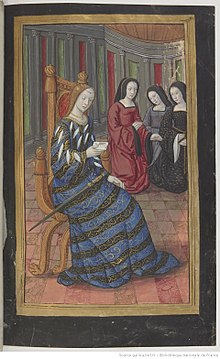InGreek mythology, Canace (/ˈkænəˌsiː/; Ancient Greek: Κανάκη, romanized: Kanákē, lit. 'barking') was a Thessalian princess as daughter of King Aeolus of Aeolia and Enarete, daughter of Deimachus.[1] She was sometimes referred to as Aeolis.[2]

Canace was the sister of Athamas, Cretheus, Deioneus, Magnes, Perieres, Salmoneus, Sisyphus, Alcyone, Calyce, Peisidice, Perimede[3] Arne and possibly Tanagra.[4] As the lover of Poseidon, she was the mother of Aloeus, Epopeus, Hopleus, Nireus and Triopas.[5]
In another, more famous version Canace was a lover not of Poseidon, but of her own brother Macareus. This tradition made them children of a different Aeolus, the lord of the winds (or the Tyrrhenian king),[6] and his wife Amphithea. Canace fell in love with Macareus and committed incest with him, which resulted in her getting pregnant. Macareus promised to marry Canace but never did. When their child was born, Canace's nurse tried to take the baby out of the palace in a basket, pretending to be carrying a sacrificial offering, but the baby cried out and revealed itself. Aeolus was outraged and compelled Canace to commit suicide as punishment, sending her a sword with which she was to stab herself. He also exposed the newborn child to its death. This story was told by Latin poet Ovid in the Heroides, a selection of eighteen story-poems that pretend to be letters from mythological women to their lovers and ex-lovers.[7] The story is also briefly referred to by Hyginus[8] and retold by Pseudo-Plutarch, in whose account Macareus kills himself over the matter as well.[9] It was also the subject of Euripides's lost play Aeolus, on which the extant versions appear to be based.
Canace's story was also put to the stage in the verse tragedy Canace (1588), by Italian playwright Sperone Speroni, as well as being the subject of a tale in Gower's Confessio Amantis. She also gave her name to the heroine of Geoffrey Chaucer's Squire's Tale.